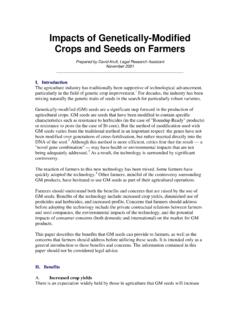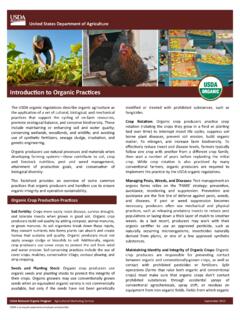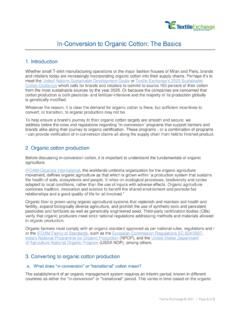Transcription of Genetically modified crops
1 PART 4 Genetically modified cropsBiotechnology encompasses a wide range of technolo-gies and they can be applied for a range of differentpurposes, such as the genetic improvement of plant va-rieties and animal populations to increase their yieldsor efficiency; genetic characterization and conservationof genetic resources; plant or animal disease diagnosis;vaccine development; and improvement of feeds. Someof the technologies may be applied to all the food andagriculture sectors, such as the use of molecular DNAmarkers or genetic modification, while others are moresector-specific, such as tissue culture (in crops and foresttrees), embryo transfer (livestock) or triploidization andsex-reversal (fish).Higher productivity holds the key in the fight against ru-ral poverty.
2 Biotechnology promises to boost productiv-ity and thus raise rural incomes, much in the same waythat the green revolution did in large parts of Asia dur-ing the 1960s to 1980s. Productivity gains encompassessentially all factors of agricultural production. Thismay mean higher crop and livestock yields, lower pesti-cide and fertilizer applications, less demanding produc-tion techniques, higher product quality, better storageand easier processing, or enhanced methods to monitorthe health of plants and type of technology, however, has given rise to a hostof concerns and questions, namelyGenetically ModifiedOrganisms(GMOs). GMOs are those organisms that havebeen modified by the application of recombinant DNAtechnology or genetic engineering, a technique used foraltering a living organism s genetic material.
3 With therapid advances in biotechnology, a number of geneti-cally modified (GM) crops or transgenic crops carryingnovel traits have been developed and released for com-mercial agriculture production. These include,inter alia,pest resistant cotton, maize, canola (mainly Bt orBacillusthuringiensis), herbicide glyphosate resistant soybean,cotton and viral disease resistant potatoes, papaya andsquash. In addition, various transgenic crops are un-der development and not yet commercially released withtraits for biofortification, phytoremediation and produc-tion of pharmaceuticals, such as rice with high level ofcarotenoid for production of Vitamin A ( golden rice)and bananas with cultivation of transgenic crops started in theearly 1990s. Herbicide tolerance and insect resistanceare the main GM traits that are currently under com-mercial cultivation, and the main crops are: soybean,maize, canola and cotton.
4 GM crops are now commer-cially planted on about 100 million hectares in some 22developed and developing countries. Argentina, Brazil,China and India are the largest developing-country pro-ducers of transgenic crops . The choice of GM crops variesamong the developing countries, with insect resistantcotton being the most important commercially producedtransgenic crop in Asian and African countries, whileherbicide-resistant soybean followed by insect-resistantcorn is predominant in the Latin American 67:No 11 33 9> 9 Area under GM crops (million ha, 2010)Source: Clive James, ISAAAM etalink: , p. 349 Almost 150 million hectares of worldcrop acreage planted with GM crops The Americas constitute the largestgrowing region, but GM cotton area issubstantial in Asia312 Genetically modified CROPSNo 11 33 9> 9 Area under GM crops (million ha, 2010)Chart 118: Genetically modified crops also becoming important in developing countriesArea under GM crops (1996-2010)Million ha10203040506070199619982000200220042006 20082010 IndustrialDevelopingSource: Clive James, ISAAAM etalink: , p.
5 350313 PART 4In most cases these GM technologies are proprietary, de-veloped by the private sector and released for commer-cial production through licensing agreements. Cultiva-tion and commercial production of GM crops are capi-tal intensive owing to high costs of seed and technol-ogy. Nevertheless, their cultivation has generally in-creased, mainly because of the benefits accrued fromlower labour and production costs, reduction in useof chemical inputs and improved economic gain. TheUnited States of America, Argentina and Canada are themajor producers and exporters of GM crops and prod-ucts. The four main global GM crops are among the ma-jor commodities traded on world increasing cultivation of GM crops has raised a widerange of concerns with respect to food safety, environ-mental effects and socio-economic issues.
6 From the foodand health perspective, the main concerns are relatedto possible toxicity and allergenicity of GM foods andproducts. Concerns about environmental risks includethe impact of introgression of the transgenes into thenatural landscape, impact of gene flow, effect on non-target organisms, evolution of pest resistance and lossof biodiversity. Adoption of GM technologies has alsoevoked a range of social and ethical concerns about re-stricting access to genetic resources and new technolo-gies, loss of traditions (such as saving seeds), private sec-tor monopoly and loss of income of resource-poor farm-ers. The scientific evidence concerning the environmen-tal and health impacts of GMOs is still emerging, butso far there is no conclusive information on the defini-tive negative impacts of GMOs on health or the environ-ment.
7 Nevertheless, public perceptions about GMOs infood and agriculture are divided with a tendency towardavoiding GM food and products in many developed anddeveloping international agreements, the Cartagena Pro-tocol on Biosafety came into force in 2003, and by Octo-ber 2011 has been ratified by 161 countries. The objec-tive of the Protocol, as stated is to contribute to ensur-ing an adequate level of protection in the field of the safetransfer, handling and use of living modified organismsresulting from modern biotechnology that may have ad-verse effects on the conservation and sustainable use ofbiological diversity, taking also into account risks to hu-man health, and specifically focusing on transboundarymovements". In a host of countries, it is also mandatoryto label products that use GM ingredients.
8 As a conse-quence, GM and non-GM crops must be kept separate,but as the area cultivated with GM varieties increases,this task is becoming more difficult and reading FAO Biotechnology ( ) FAO Biotechnologies for agricultural development( ) Cartagena Protocol on Biosafety ( )Map 68:No DataNoYesCountries that have ratified the Cartagena Protocol on Biosafety (number, 2011)Source: Convention on Biological DiversityMetalink: , p. 344 163 countries are now party to the"Biosafety Protocol" Notable exceptions include several ofthe major grain exporters, such as theUnited States314 Genetically modified CROPSNo DataNoYesCountries that have ratified the Cartagena Protocol on Biosafety (number, 2011)Chart 119: Many crops , among them food, have been subject to genetic modificationSpeciesAlfalfaMelonRoseArgen tine CanolaPapayaSoybeanCarnationPetuniaSquas hChicoryPlumSugar BeetCottonPolish canolaSweet pepperCreeping BentgrassPoplarTobaccoFlax, LinseedPotatoTomatoMaizeRiceWheatSource: ISAAAM etalink: , p.
9 349315 PART 4 Agriculture and the bio-based economyAgriculture is playing an increasingly important role inthe bio-based economy, providing feedstocks for the pro-duction of liquid fuels, chemicals and advanced ma-terials such as natural fibre composites for emergence of green industries provides expandedopportunities for the rural sector beyond traditionalforestry and the supply of wood. Biological science hasthe ability to make both incremental efficiency improve-ments and to bring about radical change in a wide rangeof sectors. This includes enzymes, fermentation and or-ganisms for processes and products in the energy, chem-ical, pharmaceutical, food, textile, and pulp and all, biological and material science working withagriculture has the greatest potential in the energy, nat-ural fibre composite and starch sectors.
10 Much of this po-tential is already being realized, especially when consid-ering the rapid growth of the biofuel sector. Currently,ethanol is being produced from easily fermentable agri-cultural feedstocks such as sugar cane, sugar beet, ce-real grains and cassava. Biodiesel is produced from veg-etable oil (typically rapeseed, soybean and palm oil) us-ing a process of chemical modification. The expansionof liquid biofuels has been rapid doubling milliontonnes in 2006 to 130 million tonnes in 2011, currentlydrawing upon feedstocks from over 45 million ha of emerging bio-based economy is based on energyefficiency, renewable feed stocks in polymer products,industrial processes that reduce carbon emissions andrecyclable materials. Natural fibres exemplify these at-tributes.

















